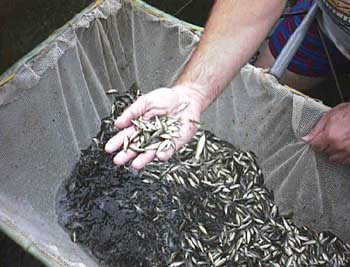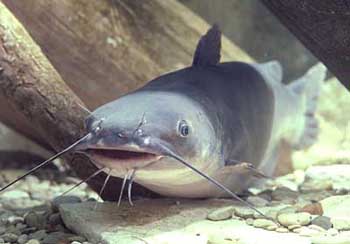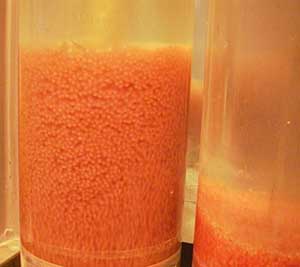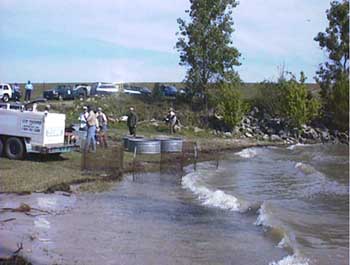Saltwater
Freshwater
Research and Support
- P.R. Bass Marine Fisheries Research Center
- Heart of the Hills Fisheries Science Center
- Analytical Services Laboratory
Volunteer Opportunities
- Hatcheries
- Stocking Reports
- Habitat Projects
- Interactive
- Research
- Fishes of Special Focus
- Find a Biologist
Fishes Produced at Freshwater Hatcheries
Florida and Northern Largemouth Bass

Largemouth bass (Micropterus salmoides) is the most sought after sport fish in Texas. State hatcheries produce two subspecies: the northern variety and the Florida largemouth bass, known for its greater size potential. TPWD has cultured northern largemouth bass since the hatcheries were built. Production and stocking of the Florida strain began in the early 1970s and has helped to make Texas one of the best bass fishing states in the nation.
Adult brood fish are kept year round at A.E. Wood, TFFC, and East Texas hatcheries. In early spring, when water temperatures reach 60°F, males and females are paired in raceways or prepared spawning ponds. In April, about 30 days after spawning, the young fish or "fry" are moved to fertilized rearing ponds. Fingerlings are collected in May and June and stocked in lakes across Texas. TPWD stocks 6 to 8 million Florida and northern largemouth bass in a typical year.
Smallmouth Bass
Smallmouth bass (Micropterus dolomieu) are stocked mainly in reservoirs in central and north-central Texas. The species was first recorded on Texas hatcheries in 1934, but a comprehensive production program was not implemented until 1974. Smallmouth bass were cultured on a large scale at Dundee Hatchery from 1994 until 2003, when the program moved to the Possum Kingdom Hatchery.
Brood fish live year round at the hatchery. In the spring when water temperatures reach 55°F, the brood fish are paired in raceways. Artificial nests made from Astroturf material are placed in raceways with the fish. When eggs are observed on the nests they are removed and taken to the hatching building. When the eggs hatch, young fry are placed into fertilized rearing ponds to grow into fingerlings of target stocking size. The TPWD hatchery program produces approximately 1 million smallmouth fingerlings each year.
Sunfish
The largemouth and smallmouth bass sought by so many Texas anglers are not true basses. They are members of the sunfish family (Centrarchidae), which also includes popular panfish such as bluegill, green sunfish, and redear sunfish. When the need exists, Texas state hatcheries can produce 0.5 million to 2.5 million sunfish for stocking in public waters.

Blue Catfish
The blue catfish (Ictalurus furcatus) is native to our larger rivers and has been introduced to larger lakes statewide. It commonly reaches 20 to 40 pounds, and specimens over 100 pounds have been recorded. Blue catfish have been cultured on Texas fish hatcheries since 1967. About mid-April, when pond water temperatures reach 65°F, breeding pairs are placed into separate pens for spawning. The spawning pens are checked for eggs daily. If found, egg masses are removed, weighed, enumerated, and placed into incubators. The eggs hatch in five to ten days. The newly hatched fry are placed into holding trays for seven to ten days until they are swimming well, and then they are moved to outdoor ponds. When stocking size is reached, fish are harvested and delivered to stocking sites around the state. The East Texas Hatchery produces approximately one million blue catfish fingerlings each season.

Channel Catfish
Every angler enjoys catching tasty channel catfish (Ictalurus punctatus). This species is native to all streams and rivers in Texas and has been widely introduced into large and small lakes. Channel cats can be caught on a variety of fishing gear. Texas state hatcheries raise approximately 500,000 fingerlings annually for stocking in reservoirs and about 300,000 10" to 12" fish which are stocked at urban fishing sites.
Brood fish live year round at the A.E. Wood Hatchery. In May, hatchery employees pair the fish in spawning pens, collect the fertilized eggs and move them to an incubation room. When fry hatch, they are stocked into growout ponds. Fingerlings are harvested from those ponds in July. Some are delivered to stocking locations. Others are transferred to rearing ponds at A.E. Wood, and many are shipped to the Dundee, East Texas, and Possum Kingdom hatcheries for rearing. Catfish continue to grow through the summer until they reach target fishing size. These larger fish are usually stocked in October and November.

Striped Bass and Hybrid Striped Bass
The striped bass (Morone saxatilis) is the largest member of the temperate bass family. The striper, as it is commonly called, spends most of its life in the ocean but migrates up streams to spawn in fresh water. After a population of stripers was landlocked during construction of a South Carolina dam in the 1940's, it was discovered that under certain conditions, this species could complete its life cycle entirely in fresh water. Each year, the Dundee and Possum Kingdom hatcheries produce millions of striped bass and hybrid striped bass (Morone saxatilis x Morone chrysops) for stocking into Texas waters. Hybrids are smaller than pure stripers, but they can tolerate a wider range of environmental conditions. For this reason, they are preferred over striped bass for stocking at certain locations. The hybrid striped bass produced at Texas hatcheries is the "original cross," that is, a male white bass is crossed with a female striped bass.
TPWD collects adult brood fish of both species in spring as they are getting ready to spawn. For hybrid production, the hatchery staff mixes white bass milt with striper eggs. Fry are stocked into growout ponds at the hatcheries, and some are traded to fishery managers in other states. Fingerlings are harvested and stocked in May and June. Texas hatcheries produce 2.5 to 3 million striped bass and a similar number of hybrid striped bass each year.
Rainbow Trout
Rainbow trout (Oncorhynchus mykiss) are not native to Texas, but the Texas Parks and Wildlife Department stocks them in each winter for recreational angling. TPWD purchases adult trout from commercial fish hatcheries. The trout arrive at state hatcheries in December. They are held and fed in ponds and indoor raceways until they are needed for the stocking program. From December through March, the five hatcheries stock more than 100 state park lakes, city and county park ponds, and other locations for a put-and-take fishery. Anglers will catch most of the trout before the water temperatures get too warm for them to survive.
Walleye and Saugeye
Walleye (Sander vitreus) is a northern cold water species and is the biggest member of the true perch family (Percidae). Saugeye is a cross between walleye and sauger (Sander canadensis). The saugeye looks nearly identical to the walleye, except that saugeye have more defined blotches. These fish prefer deep rivers and lakes with cool water and gravel or rocky bottoms. Walleye have been stocked in some West Texas lakes since the late 1960s. Saugeye have been stocked in research lakes since 1993. The Possum Kingdom hatchery obtains walleye and saugeye eggs from other states in March and April. Eggs are incubated and hatched, and fingerlings are usually stocked in May and June.
Koi Carp
Koi (Cyprinus carpio) are a type of fancy carp that have been cultured in Japan for many centuries. Texas state hatcheries raise koi as forage for captive largemouth bass brood fish. They are easy to raise, grow fast, and lack sharp dorsal spines, making them easy for the bass to eat. In an average year, the hatcheries will produce 15,000 to 20,000 kilograms of koi.